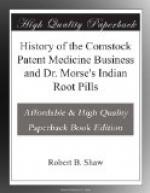But the influence of this business was by no means strictly local. For decades thousands of boxes of pills and bottles of elixir, together with advertising circulars and almanacs in the millions, flowed out of this remote village to druggists in thousands of communities in the United States and Canada, in Latin America, and in the Orient. And Dr. Morse’s Indian Root Pills and the other remedies must have been household names wherever people suffered aches and infirmities. Thus Morristown, notwithstanding its placid appearance, played an active role in commerce and industry throughout the colorful patent-medicine era.
Today, the Indian Root Pill factory stands abandoned and forlorn—its decline and demise brought on by an age of more precise medical diagnoses and the more stringent enforcement of various food and drug acts. After abandonment, the factory was ransacked by vandals; and records, documents, wrappers, advertising circulars, pills awaiting packaging, and other effects were thrown down from the shelves and scattered over the floors. This made it impossible to recover and examine the records systematically. The former proprietors of the business, however, had for some reason—perhaps sheer inertia—apparently preserved all of their records for over a century, storing them in the loft-like attic over the packaging building. Despite their careless treatment, enough records were recovered to reconstruct most of the history of the Comstock enterprise and to cast new light upon the patent-medicine industry of the United States during its heyday.
The Comstock business, of course, was far from unique. Hundreds of manufacturers of proprietary remedies flourished during the 1880s and 1890s the Druggists’ Directory for 1895 lists approximately 1,500. The great majority of these factories were much smaller than Comstock; one suspects, in fact, that most of them were no more than backroom enterprises conducted by untrained, but ambitious, druggists who, with parttime help, mixed up some mysterious concoctions and contrived imaginative advertising schemes. A few of these businesses were considerably larger than Comstock.
However, the Comstock company would seem to be typical of the more strongly established patent-medicine manufacturers, and therefore a closer examination of this particular enterprise should also illuminate its entire industry.
The Origin of the Business




